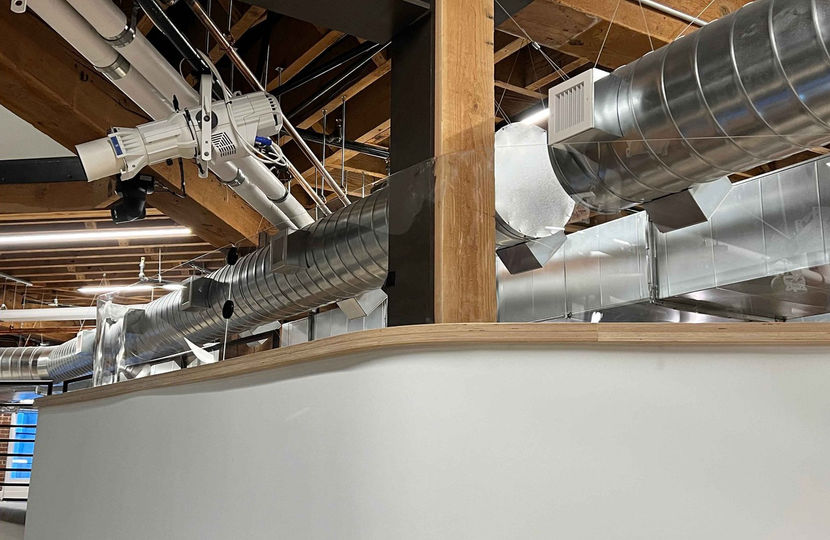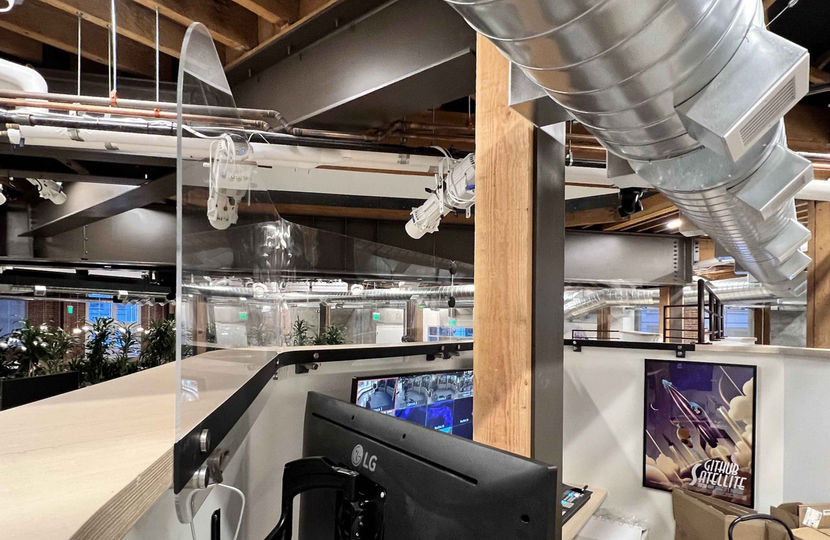
“The Nest Shield”

“The Nest” is the name given to the Audio/Video control Center in GitHub’s newly renovated headquarters In San Francisco.
Upon completion of the workplace renovation in 2021, a risk factor was recognized for the new Nest and its many tens of thousands of dollars worth of A/V equipment

My Role
The surrounding high wall of the Nest area doubled as a partition and table-height ledge for the upper most level of the bleacher-style seating that surrounds it.
The realization that someone attending a presentation or meeting who sat there may inadvertently knock food drink or otherwise on to the sensitive and expensive equipment.
I was asked to design an elegant, visually low-profile solution for protecting the area- a solution that would also fit into the new aesthetic of the remodel.

Technical Challenges: Material and Aesthetic

In order to gain approval for this job, I mocked up several approaches to demonstrate aesthetic.
Of these final four proposed, #3 was chosen for its low-profile and hidden (from the outside) fixtures/fasteners.
This choice would have major implications on two factors:
a.) The contour of the wood perimeter was curved into a custom, unique shape. Matching a curve exactly is very difficult when thermoforming plastic, and even more so when dealing with the large pieces this project would require.
b.) The over-hang seen in the following images presents a further set of unique constraints, resulting in further customized solutions in order to mount and stabilize the large pieces of acrylic.
Technical Challenges: Extracting Dimensions
I used the rough plans available as well taking measurements from the site. Measuring curve radii can be difficult, and it took several trial and error test pieces to determine the correct dimensions at which the acrylic needed to be bent.
By first measuring the radius, solving for the curved length, I ascertained the necessarry overall length of the Plexiglass shield. With the requested height of 20 inches for the Nest Shield, I determined the most economic layout and size for the panel to fit on one standard 48”x96” sheet of Acrylic.


Technical Challenges: Molding the Acrylic
“It can’t be done.”
After requesting quotes from local fabrication specialists, I was told bending such large pieces of acrylic would be impossible. However, I conducted preliminary testing and I determined that with experimentation, I could achieve the design’s required surface bending by implementing the following procedures:


1.
Using computationally accurate measurements to 3D print angled joinery to build a mold for the Acrylic.
2.
The use of appropriately curved sheet metal to conduct the heat evenly to a broad sheet of acrylic.


3.
Slow incremental bending with consistent application of heat.
Preliminary Mounting
The large plexiglass pieces needed to be held in place while measurements were taken, holes were drilled. For this purpose I had to painstakingly design brackets that would hold the plexiglass at the exact appropriate height and depth from the overhang of the wood.
These were temporarily attached by two screws to underside of the wood protrusion. Though developing these pieces was time consuming, the job of mounting the acrylic would have been impossible in their absence.

Final Mounting

Due to the top piece of wood’s varying overhang lengths/depths, I had to design mounting couplings to screw into the wall surface at three separate points per stand-off support.
The multiple points of contact compensated for shallowness of the fasteners (due the steel reinforcement behind the drywall being impractical to drill into). After measuring each point where it would be mounted, I 3D-printed each coupling and fastened to the wall.
I used steel and soft plastic washers to create a gentle buffer between steel and the area of acrylic where pressure was being applied.
I used the GitHub “Octocat” Logo as inspirtation for the coupling of the two panels. I designed and 3d-printed the pieces to bridge the gap between two sets of laser-cut holes on each piece of Acrylic.

The installed Nest Shield was delivered on schedule and to “beyond-satisfatory” completion. The Nest Shield can be seen in GitHub’s headquarters today protecting the A/V team’s equipment and personnel.









